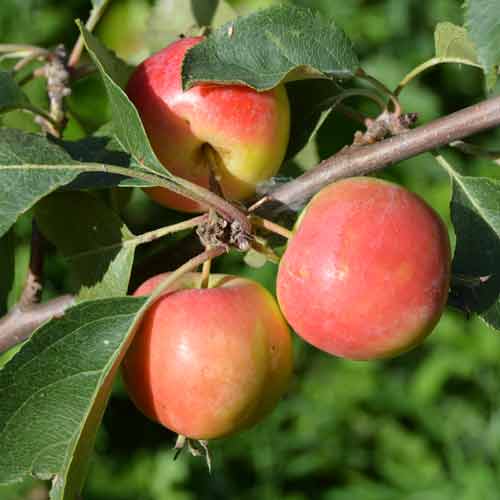Apple Rootstock Guide
Commercial fruit trees usually consist of two parts, the scion (the fruiting variety) which makes up most of the tree that you see above ground-level, and the rootstock which – as the name suggests – consists of the roots and lower portion of the trunk. The join or “union” is easy to spot in a young tree – it is the kink a few inches above the ground where the scion was budded or grafted on to the rootstock. This marriage works because rootstocks are very closely related to scions – thus apple rootstocks are apple varieties in their own right, but where the main attribute is not fruit quality but tree size.
The variety selected for the scion imparts the fruit characteristics such as size, color, and quality factors. The variety selected for the rootstock determines tree size, precocity, some disease resistance (such as fireblight) and even cold hardiness. And like the fruiting varieties, rootstocks also undergo breeding and selection for their desired characteristics.

M9 – dwarf
One of the most widely-used rootstocks in commercial apple orchards. Apple trees on M9 are very productive and come into bearing within 2-3 years of planting, the tree reaches full size after about 5 years. The fruit size is sometimes slightly larger than on other rootstocks.
Permanent stake required. Watering and feeding required.
Ground around the tree should be kept weed-free (e.g. mulched).
M9/M111 interstem – semi-dwarf
By adding an interstem of M9 on top of the MM111 rootstock it is possible to produce a free-standing tree which needs little looking after (because of the vigorous MM111 rootstock which is suitable for almost any soil conditions) but with the precocity, disease resistance, and smaller size of M9. The resulting tree does not need staking, fruits early in its life (depending on the scion variety)
M7 – semi-dwarf
The most widely planted freestanding semi-dwarf rootstock. EMLA 7 trees exhibit an open spreading-type growth. Trees on M.7 EMLA produce a semi-dwarf tree about 60 to 70% as big as seedling. Trees are moderately precocious and may lean with some cultivars and may require trunk support. Trees tend to produce many rootsuckers.
M111 – semi-standard
MM111 is one of the most adaptable of all rootstocks, and will grow in a very wide range of soil conditions. Noted for its good drought tolerance and ability to grow on difficult soils.
Comes into fruit-bearing after 4-5 years and reaches full size after about 10 years. It is a good choice for a traditional orchard.
